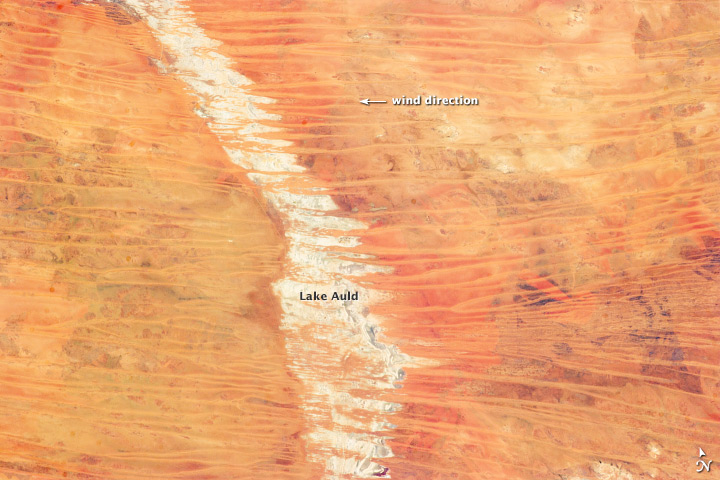NASA: Australia - Great Sandy Desert - 12.04.13
Posted by Ricardo Marcenaro | Posted in NASA: Australia - Great Sandy Desert - 12.04.13 | Posted on 13:29
In northwest Australia, the Great
Sandy Desert holds great geological interest as a zone of active sand
dune movement. While a variety of dune forms appear across the region,
this astronaut photograph features numerous linear dunes (about 25
meters high) separated in a roughly regular fashion (0.5 to 1.5
kilometers apart). The dunes are aligned to the prevailing winds that
generated them, which typically blow from east to west. Where linear
dunes converge, dune confluences point downwind. When you fly over such
dune fields—either in an airplane or the International Space Station—the
fire scars stand out. Where thin vegetation has been burned, the dunes
appear red from the underlying sand; dunes appear darker where the
vegetation remains.
Strings of narrow lakes that represent ancient rivers are also present in the region. The white feature down the center of the image is Lake Auld; the color is the result of a cemented combination of fine, clayey sediment and salts from the evaporation of flood waters that occasionally fill the lake. Wider views of the area show that Lake Auld is part of what was once a major river system draining northwest to the Indian Ocean. Such sinuous lakes are also known in Australia as “river lakes.” (Other views showing the ancient winding rivers are available here and here.)
The river system is remarkably well preserved, considering that the rivers were probably active in the Paleocene Epoch more than 55 million years ago. At the time, the Australian land mass was much further south, in a wetter climatic zone. Almost all rivers in the Great Sandy Desert are dry in today’s desert climate.
Linear dunes can be seen entering Lake Auld on the east side. During flooding events, the sand of the dune noses is dispersed, becoming incorporated into the muds and salts of the lake floor sediments. During the long, intervening dry periods, sand can blow across the lake floor to build thinner, smaller dunes, visible as linear accumulations on the west side of the lake.
Strings of narrow lakes that represent ancient rivers are also present in the region. The white feature down the center of the image is Lake Auld; the color is the result of a cemented combination of fine, clayey sediment and salts from the evaporation of flood waters that occasionally fill the lake. Wider views of the area show that Lake Auld is part of what was once a major river system draining northwest to the Indian Ocean. Such sinuous lakes are also known in Australia as “river lakes.” (Other views showing the ancient winding rivers are available here and here.)
The river system is remarkably well preserved, considering that the rivers were probably active in the Paleocene Epoch more than 55 million years ago. At the time, the Australian land mass was much further south, in a wetter climatic zone. Almost all rivers in the Great Sandy Desert are dry in today’s desert climate.
Linear dunes can be seen entering Lake Auld on the east side. During flooding events, the sand of the dune noses is dispersed, becoming incorporated into the muds and salts of the lake floor sediments. During the long, intervening dry periods, sand can blow across the lake floor to build thinner, smaller dunes, visible as linear accumulations on the west side of the lake.
Astronaut photograph ISS035-E-9454
was acquired on March 25, 2013, with a Nikon D3S digital camera using a
400 millimeter lens, and is provided by the ISS Crew Earth Observations
experiment and Image Science & Analysis Laboratory, Johnson Space
Center. The image was taken by the Expedition 35 crew. It has been cropped and enhanced to improve contrast, and lens artifacts have been removed. The International Space Station Program supports the laboratory as part of the ISS National Lab
to help astronauts take pictures of Earth that will be of the greatest
value to scientists and the public, and to make those images freely
available on the Internet. Additional images taken by astronauts and
cosmonauts can be viewed at the NASA/JSC Gateway to Astronaut Photography of Earth. Caption by M. Justin Wilkinson, Jacobs/ESCG at NASA-JSC.
- Instrument:
- ISS - Digital Camera
NASA: Australia - Great Sandy Desert - 12.04.13



Comments (0)
Publicar un comentario